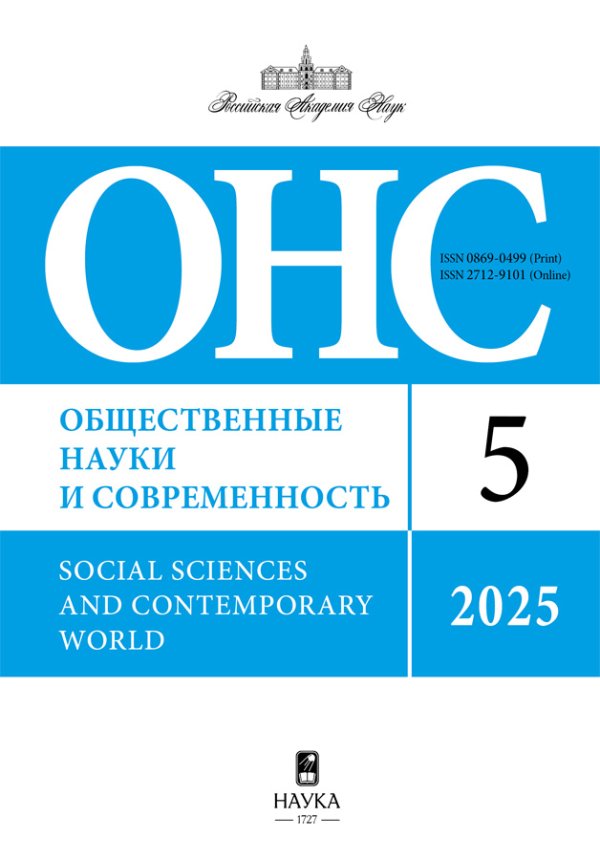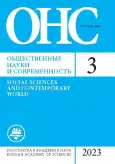Representation of women in regional parliaments: testing the model of traditional gender roles
- Authors: Mukhametov R.S.1
-
Affiliations:
- Ural Federal University named after the First President of Russia B.N. Yeltsin
- Issue: No 3 (2023)
- Pages: 131-145
- Section: Gender studies
- URL: https://journals.rcsi.science/0869-0499/article/view/141873
- DOI: https://doi.org/10.31857/S0869049923030097
- EDN: https://elibrary.ru/GIQWFE
- ID: 141873
Cite item
Full Text
Abstract
About the authors
Ruslan S. Mukhametov
Ural Federal University named after the First President of Russia B.N. Yeltsin
Email: muhametov.ru@mail.ru
Yekaterinburg, Russia
References
- Айвазова С.Г. (2002) Гендерные исследования современных политических процессов в России // Женщина в российском обществе. № 2-3. С. 24-32.
- Здравомыслова Е.А., Темкина А.А. (2003) Государственное конструирование гендера в советском обществе // Журнал исследований социальной политики. № 3/4. С. 299-321.
- Козлова Н., Монахова Ю. (2019) Женщины-депутаты представительных органов Приволжского федерального округа: опыт анализа политических биографий // Вестник Пермского университета. Сер. Политология. № 2. С. 57-69. doi: 10.17072/2218-1067-2019-2-57-69.
- Кон И.С. (2008) Мужская роль и гендерный порядок // Вестник общественного мнения. Данные. Анализ. Дискуссии. № 2. С. 37-43.
- Кочкина Е.В. (2013) Законодательство о выборах в Государственную Думу Федерального Собрания РФ, 1993-2013 гг.: гендерные ограничения и возможности квотирования. М.: Вариант. 153 с.
- Мухаметов Р.С. (2021а) Влияние величины избирательных округов на гендерный состав муниципального депутатского корпуса // Общественные науки и современность. № 5. С. 43-55. doi: 10.31857/S086904990017284-4.
- Мухаметов Р.С. (2021b) Высокое представительство женщин в парламенте и пропорциональная избирательная система: работает ли эта взаимосвязь в России? // Сравнительная политика. № 2. С. 82-93. doi: 10.24411/2221-3279-2021-10021.
- Рябова Т.Б., Овчарова О.Г. (2016) Гендерная политология в России: достижения, проблемы и перспективы // Женщина в российском обществе. № 1. С. 3-23.
- Рябова Т.Б. (2008) Пол власти: гендерные стереотипы в современной российской политике. Иваново: Иван.гос. ун-т. 246 с.
- Рябова Т.Б., Рябов О.В. (2020) "…Слышу речь не мальчика, но мужа": о гендерно-возрастных стереотипах в политике // Женщина в российском обществе. № 4. С. 5-13. doi: 10.21064/WinRS.2020.4.1.
- Силласте Г.Г. (2022) Мировой гендерный ландшафт и страновой гендерный порядок в условиях глобальной трансформации социальных систем // Век глобализации. № 3. С. 112-131.
- Силласте Г.Г. (2019) Социальные транзиции и формирование нового гендерного порядка // Женщина в российском обществе. № 2. С. 3-16. doi: 10.21064/WinRS.2019.2.1.
- Хасбулатова О.А. (2001) Гендерные стереотипы в политической культуре: специфика российского опыта // Женщина в российском обществе. № 3-4. С. 17-24.
- Шведова Н.А. (2018) Гендерный аспект президентской кампании 2016 года в США // Американский ежегодник. № 2017. С. 57-65.
- Adams K. (2011) Moving towards Gender Parity: Female Representation in National Legislatures, 2001 and 2011 // International Journal of Interdisciplinary Social Sciences. Vol. 6. No. 3. Рр. 55-74.
- Adebayo S., Olawa B., Osasogie O. (2015) Quality of Family Relationships: The Contributions of Family Structures and Gender - Role Orientations // Social and Natural Sciences Journal. Vol. 9. No. 1. Рр. 1-4. doi: 10.12955/snsj.v9i1.718.
- Atkeson L. (2003) Not All Cues Are Created Equal: The Conditional Impact of Female Candidates on Political Engagement // The Journal of Politics. Vol. 65. No. 4. Рр. 1040-1061. doi: 10.1111/1468-2508.t01-1-00124.
- Bos A., Greenlee J., Holman M., Oxley Z., Lay J. (2022) This One's for the Boys: How Gendered Political Socialization Limits Girls' Political Ambition and Interest // American Political Science Review. Vol. 116. No. 2. Рр. 484-501. doi: 10.1017/S0003055421001027.
- Burns N., Schlozman K., Verba S. (2001) The Private Roots of Public Action: Gender, Equality and Political Participation. Cambridge: Harvard University Press. 453 р.
- Dolan J., Deckman M., Swers M. (2010) Women and Politics: Paths to Power and Political Influence. New York: Pearson. 448 р.
- Eagly A., Wood W. (1999) The Origins of Sex Differences in Human Behavior // American Psychologist. Vol. 54. No. 6. Рр. 408-423. doi: 10.1037/0003-066X.54.6.408.
- Eagly A., Wood W. (2012) Social Role Theory // In: Handbook of Theories of Social Psychology. Vol. 2. Thousand Oaks: SAGE Publications Ltd. Рр. 458-476. doi: 10.4135/9781446249222.n49.
- Eagly A., Wood W., Diekman A. (2000) Social Role Theory of Sex Differences and Similarities: A Current Appraisal // In: The Developmental Social Psychology of Gender. Mahwah, NJ: Erlbaum. Рр. 123-174.
- Golosov G. (2014) Is Electoral Authoritarianism Good for Women's Representation? Evidence from the 1999-2011 Regional Legislative Elections in Russia // Post-Soviet Affairs. Vol. 30. No. 1. Рр. 51-66. doi: 10.1080/1060586X.2013.831653.
- Golosov G. (2001) Political Parties, Electoral Systems and Women's Representation in the Regional Legislative Assemblies of Russia, 1995-1998 // Party Politics. Vol. 7. No. 1. Рр. 45-68. doi: 10.1177/1354068801007001003.
- Inglehart R., Norris P. (2001) Women and Democracy: Cultural Obstacles to Equal Representation // Journal of Democracy. Vol. 12. No. 3. Рр. 126-140. DOI: 10.1353/ jod.2001.0054.
- Judge T., Livingston B. (2008) Is the Gap More Than Gender? A Longitudinal Analysis of Gender, Gender Role Orientation, and Earnings // Journal of Applied Psychology. Vol. 93. No. 5. Рр. 994-1012. doi: 10.1037/0021-9010.93.5.994.
- Kunovich S., Paxton Р. (2005) Pathways to Power: The Role of Political Parties in Women's National Political Representation // American Journal of Sociology. Vol. 111. No. 2. Рр. 505-552. doi: 10.1086/444445.
- Lawless J., Fox R. (2003) Family Structure, Sex-role Socialization, and the Decision to Run for Office // Women & Politics. Vol. 24. No. 4. Рр. 19-48. doi: 10.1300/J014v24n04_02.
- McIntyre S., Montgomery D., Srinivasan V., Weitz B. (1983) Evaluating the Statistical Significance of Models Developed by Stepwise Regression // Journal of Marketing Research. Vol. 20. No. 1. Рp. 1-11.
- Moser R., Rybalko M. (2022) Representation of Women and Ethnic Minorities in the Russian State Duma 1993-2021 // Russian Politics. Vol. 7. No. 2. Рр. 311-339. doi: 10.30965/24518921-00604022.
- Moser R.G. (2001) The Effects of Electoral Systems on Women's Representation in Post-Communist States // Electoral Studies. Vol. 20. No. 3. Рр. 353-369. doi: 10.1016/S0261-3794(00)00024-X.
- Norris P., Lovenduski J. (1995) Political Recruitment. Gender, Race and Class in the British Parliament. Cambridge: Cambridge University Press. 320 р.
- Paxton Р., Kunovich S. (2003) Women's Political Presentation: The Importance of Ideology // Social Forces. Vol. 82. No. 1. Рр. 87-113. doi: 10.1353/sof.2003.0105.
- Riabov O. (2020) The Symbol of the Motherland and in the Legitimation and Delegitimation of Power in Contemporary Russia // Nationalities Papers. Vol. 48. No. 4. Рр. 752-767. doi: 10.1017/nps.2019.14.
- Riabova T., Riabov O. (2019) The "Rape of Europe": 2016 New Year's Eve Sexual Assaults in Cologne in Hegemonic Discourse of Russian Media // Communist and Post-Communist Studies. Vol. 52. No. 2. Рр. 145-154. doi: 10.1016/j.postcomstud.2019.04.004.
- Ross M. (2008) Oil, Islam, and Women // American Political Science Review. Vol. 102. No. 1. Рр. 107-123. doi: 10.1017/S0003055408080040.
- Salmond R. (2006) Proportional Representation and Female Parliamentarians // Legislative Studies Quarterly. Vol. 31. No. 2. Рр. 175-204. doi: 10.3162/036298006x201779.
- Temkina A., Zdravomyslova E. (2003) Gender Studies in Post-Soviet Society: Western Frames and Cultural Differences // Studies in East European Thought. Vol. 55. No. 1. Рp. 51-61.
- Thames F. (2017) Understanding the Impact of Electoral Systems on Women's Representation // Politics & Gender. Vol. 13. No. 3. Рр. 379-404. doi: 10.1017/S1743923X16000325.
- Valentova M. (2016). How Do Traditional Gender Roles Relate to Social Cohesion? Focus on Differences between Women and Men // Social Indicators Research. Vol. 127. No. 1. Рр. 153-178. doi: 10.1007/s11205-015-0961-2.
- Wilkinson L., Dallal G. (1981) Tests of Significance in Forward Selection Regression with an F-to-Enter Stopping Rule // Technometrics. Vol. 23. No. 4. Рр. 377-380.
- Yoon M. (2004) Explaining Women's Legislative Representation in Sub-Saharan Africa // Legislative Studies Quarterly. Vol. 29. No. 3. Рр. 447-468. doi: 10.3162/036298004X201258.
Supplementary files










